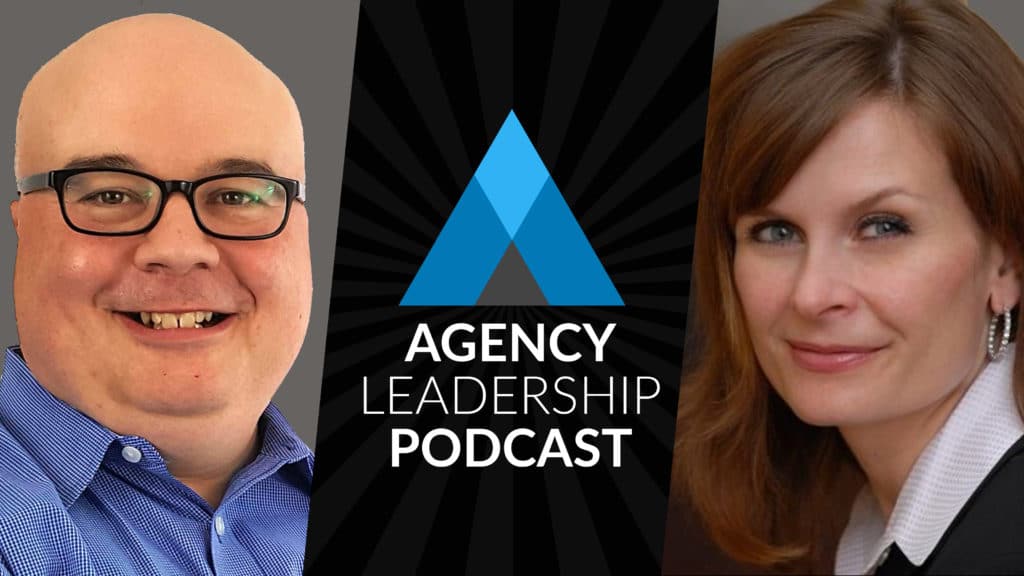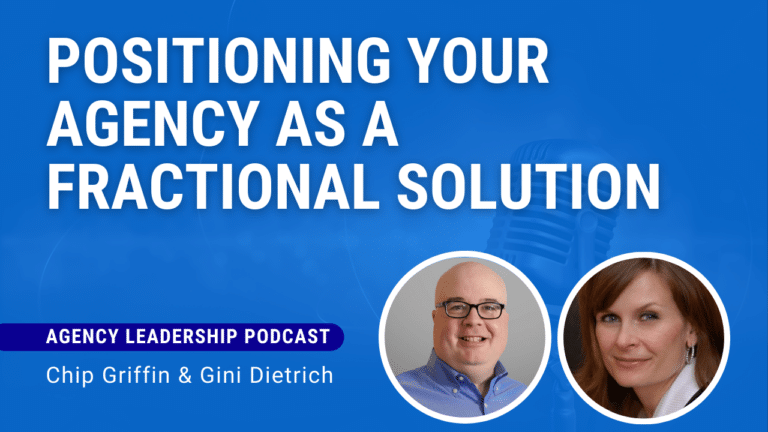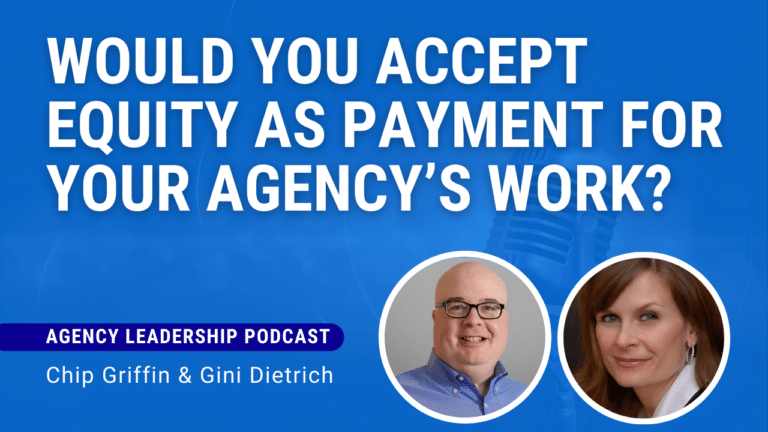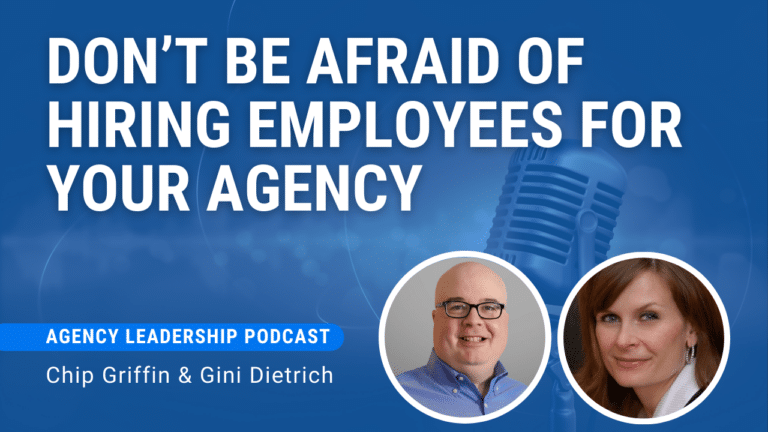Podcast: Download
Chip and Gini will be recording a couple of separate solo episodes since scheduling conflicts prevented them from recording together recently. (Of course, we would love to hear your feedback about these and some of the other formats we have experimented with recently, including guest co-hosts.)
In this episode, Gini fields a question from Kevin Anselmo who asks about pitching agency services to prospects, including cold calling and other techniques. She explains her approach which centers around creating VIP lists of potential clients.
After you use such a list to get a meeting, Gini explains her style during initial consultations: “People want to be around people who challenge them. They want to be around people who make them think differently.”
Resources
- Kevin Anselmo on LinkedIn | Twitter
- Experiential Communications
- Fanatical Prospecting by Jeb Blount
Transcript
The following is a computer-generated transcript. Please listen to the audio to confirm accuracy.
Welcome to another episode of the Agency Leadership Podcast. I am Gini Dietrich.
Chip Griffin and I are going our separate ways just for a couple of weeks, not forever. It’s, as most of you know, is a crazy time of year war clients are trying to spend budgets they haven’t spent and they’re trying to allocate budgets for next year. And because of that Chip and I have had a hard time while that and a sick kid and a funeral and other things that personal lives have thrown our way. We’ve had a hard time figuring out how to get together to record some episodes.
So with that, we’re going to do some solo episodes. It probably — no, not probably, it definitely will not be as entertaining. I don’t have anybody to make fun of if he’s not here. And I’m certainly going to have to do my own segue at the end. So we’ll see how we go how we do.
Kevin Anselmo is a podcaster and does a lot of work in university and education PR sent a note to Chip that said, “electronic communications are great, but seeing people in person talking on the phone or sending handwritten notes offers even more value in the digital age. I would be interested in your thoughts about prospecting and related to the above post using the phone. Just read the book fanatical prospecting by Jeb Blount. I don’t agree with everything he says. But he did give me some ideas that I plan to implement as it relates to using the phone to prospect more but more deliberately, around the ideal work I want to do. I’d be interested in hearing you and Gini discuss questions such as and then he says, Is there a place for cold calling? If yes, what’s the best way to approach this? If a warm lead were the best ways to interrupt someone over the phone? How have you refined your respective short pitches regardless of medium howdy You go about getting time on the calendar in the most efficient way possible with prospects for more in depth business development discussions? And what is your approach on these pitch calls slash meetings?”
So some really great questions here. Kevin, I definitely have a perspective. I’d love to hear Chip’s response to these because I think he probably will agree with some and disagree with others, but for now, you get to hear my thoughts and then he can come back later and add in his
So first of all, I’ve not read Fanatical Prospecting and definitely will be something that I pick up. Kevin, like you I imagine I will agree with some of it and not with all of it.
I have found just like in pitching media, that phone phone calls are hard. And I have also found that they work better when you’ve had at least one meeting. So here’s how I like to go about it. And here’s how I recommend our agency owners do it weekly Create VIP lists. And I do this probably, I’d say four times a year I do this I create a list of VIP there.
These are people who I know a are in the market for our services or have been in the market for our services, or have mentioned at some point that they’re looking for services or you know, we I know that they’re going to hire a communications firm in some fashion. And be that they’ll they’ll answer my email and set up a meeting if I email and ask so it’s not cold calling from the perspective of they don’t know who I am. And I’ll get to that in a minute from a dream client perspective.
But it’s cold, it’s cold from the perspective of they didn’t say, Hey, I’m, we’re looking for help, can you help us? And what I do is I just send an email.
So let me give you a really great example. I am a cyclist. And earlier this summer, like a June ish, probably Close to the start of the season was a very late start to the season this year. We usually start in late March, early April and this year it was June. And of me it was very miserable. We’ve also had a very early winter, but that’s neither here nor there. But early earlier in early in the season I was riding with with a guy that I ride with every season. And he was talking about how frustrated he was with his PR person. And he went on to describe you know, in the beginning, she was really great because she would come come up with ideas she was calling all the time, she was super proactive. She would say Hey, I just met with so and so and I think it’d be interesting for you to talk about this. And it wasn’t just as he called it PR but I would call it Media Relations. It was sponsorships and events and and awards and speaking engagements and things like that. And she was really proactive and he said in the last couple of years she’s become more interested in art and in selling her art and in combining her art with her clients and it just doesn’t work for their business.
And so he was venting a little bit. And I asked some questions, and I gave him some ideas, and I kind of set him on the right path. You were riding almost 100 miles. So it was a long conversation. And really, it’s at that point, it wasn’t something that we would have handled, and still is not something that we would handle. But there’s, there is something that we would handle, which is I think I’ve talked about before our two day strategy session. And that’s not always appropriate at that time. I didn’t feel like that was appropriate. So right after Labor Day, I saw I’m cycling and I was like, Hey, how are things going with your PR? Here’s a person and he’s like, Oh, we parted ways. I’m looking for a new firm blah, blah, blah. And I said, well, let’s have lunch and see how it goes.
Now. That’s pretty warm, right? I’m having I’m having an in person conversation with him although not looking at him because I’m looking at the road ahead of me and I’m breathing heavily because I’m you know, sprinting or trying to keep up with him and But it definitely is, from that perspective, a warmer lead and it is in person. So he was on my VIP list.
But if it’s somebody who I’m not going to see in person, I’ll email them. And I’ll say, Hey, you know, how are things going the last time we talked, you said this, this, this and this or last time we talked to you that you thought you were going to be doing this, how is that going or last time we talked, you know, whatever it is, like related back to the conversation you current you had at one point, and then say, you know, I’d love to have a conversation with you to see if there’s anything that we can do.
And 99.999% of the time they email back and they’re like, yeah, great, awesome. Let’s get coffee or lunch or zoom chat or whatever happens to be if they’re not in, if, if they’re not in a place where you can be in person. It works extraordinarily well.
So the beginning of September, I sent a 10 of those emails, and I had nine meetings and we’ve closed eight of them. So you know, the conversion rates per Good.
And it is something to Kevin’s point, what’s the approach on those pitches, calls meetings. It’s it’s definitely our today strategy session process because we we will not work with anybody if they don’t go through that process first. And I’ve certainly had meetings, there were two meetings of the 10, where they one person was not ready. And the other person said, Look, we just really want Media Relations. And I was like, Okay, I can make some referrals for you. But that’s not what we’re going to do if you’re not going to go through this process with us so that we can understand that that truly is what you need, not what you think you need, then it’s not going that we’re not the right firm for you. And I referred him to three agencies that do Media Relations really well.
So I’ll come back to that in a minute and kind of talk through that process.
But the whole point here is that I’m not using the phone to interrupt them because I think it’s it’s significantly more challenging than an email. But I do use the phone or coffee or lunch or whatever. happens to be you know if I can do an in person or a zoom video chat as the next step so the email is the quote unquote interrupter I’m not interrupting them on the phone and then the conversation that more in depth conversation happens in one of those ways.
I do you think that there’s a place for cold calling and one of the other things that we work with on our with our agency on our clients is building a dream client list. So if everything works exactly the way you wanted it to to who would be on that list and for me, it would be cycling companies right it would be trek it might be survey low, it might be pearl Izumi, it might be belt like, you know, there, there are lots of companies inside the cycling industry. That for me would be phenomenal. You know, the Armstrong foundation even though Lance’s not, they’re trying to separate themselves from Lance Armstrong. So those kinds of things you know, would be on my personal dream list is Not those aren’t necessarily on the company on the agency dream list, because not everybody can get as passionate about it as I can. But that’s one of the exercises we do.
So if you’re a solo practitioner, you can create the list of things that you’re passionate about. I have one client who will only work with mission based organizations. And it has to be something that she believes in. And she had be based on that she’s a virtual organization is she hires contractors who have the same passion around those things that she does. So you can control that piece of it. And if you have a larger team, then you say, hey, let’s let’s brainstorm. Let’s talk about what who are our dream clients. And then what we recommend you do is go into LinkedIn and see if you have any connections in common. And if you do great because then you can say to your connection, and let’s just use Kevin in this prospect in this example, Hey, Kevin, I see that you’re connected to the Chief Marketing Officer at Trek. I would freakin love to do that work. I wouldn’t love to work with them. And I know that that’s not something you would ever do because you focus on education. Would you mind making an introduction?
And hopefully he says, Yes, not not a problem, I would love to make an introduction. And we can go from there. So it’s still cold from that perspective, but you’re getting and you don’t know if they’re qualified lead yet you don’t know if they’re looking for a new agency or anything like that. So you can, you can make it less cold, you can make it a little more warm with that introduction. Now, if it’s somebody that you don’t have a connection to, and there’s no way of figuring that out, that’s a completely different bailiwick, and a podcast episode we can focus on later. But those are the kinds of things that I do to make it less quote unquote cold.
Like do I think that there’s a place for picking up the phone and calling people all day every day? Absolutely not. No way. It doesn’t work in media relations. It doesn’t work in new business development. I don’t recommend it. But there are things that you can do to make them more quote unquote warm to that. And he asked how have you refined your respective short pitches regardless of medium? And we don’t i don’t really pitch ourselves. I don’t pitch us in the because in those introductory emails or anything like that because people don’t read them. And nobody’s going to respond to a voicemail that you leave that talks that has your short short pitch. So I use I instead use the opportunity of a meeting to diagnose their challenges, figure out what works, figure out what success they’ve had, do some intuitive questioning and things like then some, you know, some coaching through that and show them how smart we are because we can ask really smart questions.
And at the end, either I say, I think we can help you and this is our process or, gosh, it sounds like you need this or this and I’d love to make a recommendation. I never figure that it’s a lost cause, even if it’s not something that we would do, because I believe in karma and paying it forward and all those kinds of things. And you’d be surprised at how many people come back and say, Okay, we’re ready for you now, thank you for that three years ago, but we’re ready for you now. And we have the budget to pay for it.
So I believe in all those kinds of things. So I never see never look at it as a lost cause. Of course, I would love to convert 100% of the meetings that I have, but I’ll take 80% 80% is pretty good. So think about it from that perspective. And really, when you’re thinking about refining your short pitch, I would do it in from the perspective of the last 10 minutes of the meeting, versus trying to talk about yourself and all the great things you do during the meeting, or even in the email, the introductory email or you know, really, to get a meeting it should just say and this is what we we work with on our, with our with with our clients is hey, let’s time we talked, you said this, I’d love to talk to you more about it, let’s schedule a meeting, I will tell you that this time of year, the last quarter of the year is the very best time to do this stuff.
So I highly, highly, highly recommend. If you haven’t already done something like this before the end of the year, get it done, create a list of 10. VIP and start sending emails because you will you you will, this is the best time to do it. People are setting their budgets for next year. So this is the very best time to to hit them. And then let’s see how do you go about getting time on calendar in the most efficient way possible?
So we talked about that and then the approach in the in the business pitches. So I talked a little bit about this, but the idea is that I truly do I diagnose the problem. I asked one of the things one of the very first questions I ask is What is your biggest challenge from a communications perspective? I asked if they’ve worked with indications from before if they have, what they liked, what they didn’t like, what kinds of results they expect, I always ask, what do you expect your communications program to do?
And I’ve had everything from, you know, I understand that it’s, it’s brand awareness. And we really, we need to increase market share, and we need to increase your voice and share of mind. And then I’ve gotten things like I need you to make my phone ring off the hook. Those are completely different conversations and different recommendations, right. So you have to ask those kinds of questions. And then you have to decide as well, if they want you to make the phone ring, is that something you can deliver on? If it’s not, you can refer them off if it is that, like I said, it’s a completely different recommendation.
So I asked questions and I asked questions, I asked questions and I take a bunch of notes and I you know, circle things and I start things and I put bubbles around things that are important and then at the end, I go come back and I say okay, you told me this, this, this and this, is that true. Can you if we Talk about this and this. And it results in this would you be happy. And so you sort of you reap not sort of you repeat back to them what they told you. And now you’re saying it in their own words in the words that they used, and they start to feel very comforted, like you know what you’re doing. And I say this to our clients all the time.
When you ask really smart questions, and let them do all the talking, they believe that you are the smartest person in the room. And people will say to me all the time, but I didn’t say anything. I didn’t even talk about our case studies are what we do or anything, right? Because you let them talk and because you ask them really smart questions. And when you ask really smart questions that make their brains itch, they go, Oh, I need this person around.
Now of course there are some people that would not be ideal clients for you, I would imagine because they want to have Yes, men around and they don’t want to be pushed. But for the most part People want to be around people who challenge them. They want to be around people who make them think differently. They want to be around people who make them uncomfortable, because they know that’s how they’re going to grow. So if you ask really smart questions and you keep them talking, they will think you’re smart. And then at the end, all you have to do is talk about your process.
And one of the things that I really truly believe, is there has to be something clear cut, there has to be something that they are buying, and it has to be a fast deliverable. So for us, it’s a two day strategy session. We can you know, it costs this much money, you sign an agreement, you pay for it, as soon as we receive payment, we can book that meeting.
So depending on schedules, it could be in the next two weeks, it could be in the next month, but it’s in the usually within the first 30 to 45 days of of you having that meeting. And then the deliverable is they get a customized strategic communications plan that they were collaborative in creating And that always leads to more work and higher budgets because now you’re part of the team, instead of just a vendor coming in and recommending something that you recommend to for everybody else, because you do Media Relations, or you do graphic design, or you do website development, and that’s what you do. Instead, it’s a collaborative collaborative approach, where they now think of you as a trusted advisor.
So Kevin, I hope that that answers all of your questions. I’m going to pick up fanatical prospecting to see if there’s anything in there that triggers something for me and I’ll follow back up probably after the new year.
But there you go, there is a place for cold calling. I prefer it to be a little more warm with some introduction, but still not you know, it’s still going to be cold from the perspective that you don’t they don’t know you, you don’t know them. And you don’t know if they need your services. There are ways to do it without necessarily interrupting over the phone, you can interrupt their inbox you can interrupt their their direct messages on social and really think about what your approach and those new business meetings are so that you have something that you can give them that has a flat fee and can be delivered really quickly. And if you do those three things, and especially this time of year, you will have success.
And with that brings us to the end of the Agency Leadership Podcast. I’m Gini Dietrich and it depends







